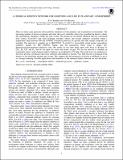Files in this item
A chemical kinetics network for lightning and life in planetary atmospheres
Item metadata
| dc.contributor.author | Rimmer, Paul | |
| dc.contributor.author | Helling, Christiane | |
| dc.date.accessioned | 2016-06-17T12:30:03Z | |
| dc.date.available | 2016-06-17T12:30:03Z | |
| dc.date.issued | 2016-05 | |
| dc.identifier | 240205514 | |
| dc.identifier | 9d4bf4a6-f9c6-4d5c-b382-9b51622acb0c | |
| dc.identifier | 84977639213 | |
| dc.identifier | 000377050200009 | |
| dc.identifier.citation | Rimmer , P & Helling , C 2016 , ' A chemical kinetics network for lightning and life in planetary atmospheres ' , Astrophysical Journal Supplement Series , vol. 224 , no. 1 , 9 . https://doi.org/10.3847/0067-0049/224/1/9 | en |
| dc.identifier.issn | 0067-0049 | |
| dc.identifier.uri | https://hdl.handle.net/10023/9008 | |
| dc.description.abstract | There are many open questions about prebiotic chemistry in both planetary and exoplanetary environments. The increasing number of known exoplanets and other ultra-cool, substellar objects has propelled the desire to detect life and prebiotic chemistry outside the solar system. We present an ion-neutral chemical network constructed from scratch, Stand2015, that treats hydrogen, nitrogen, carbon, and oxygen chemistry accurately within a temperature range between 100 K and 30,000 K. Formation pathways for glycine and other organic molecules are included. The network is complete up to H6C2N2O3. Stand2015 is successfully tested against atmospheric chemistry models for HD 209458b, Jupiter, and the present-day Earth using a simple one-dimensional photochemistry/diffusion code. Our results for the early Earth agree with those of Kasting (1993) for CO2, H2, CO, and O2, but do not agree for water and atomic oxygen. We use the network to simulate an experiment where varied chemical initial conditions are irradiated by UV light. The result from our simulation is that more glycine is produced when more ammonia and methane is present. Very little glycine is produced in the absence of any molecular nitrogen and oxygen. This suggests that the production of glycine is inhibited if a gas is too strongly reducing. Possible applications and limitations of the chemical kinetics network are also discussed. | |
| dc.format.extent | 35 | |
| dc.format.extent | 1971187 | |
| dc.language.iso | eng | |
| dc.relation.ispartof | Astrophysical Journal Supplement Series | en |
| dc.subject | Astrobiology | en |
| dc.subject | Atmospheric effects | en |
| dc.subject | Molecular processes | en |
| dc.subject | Planetary systems | en |
| dc.subject | QB Astronomy | en |
| dc.subject | QC Physics | en |
| dc.subject | NDAS | en |
| dc.subject | BDC | en |
| dc.subject.lcc | QB | en |
| dc.subject.lcc | QC | en |
| dc.title | A chemical kinetics network for lightning and life in planetary atmospheres | en |
| dc.type | Journal article | en |
| dc.contributor.sponsor | European Research Council | en |
| dc.contributor.institution | University of St Andrews. School of Physics and Astronomy | en |
| dc.identifier.doi | https://doi.org/10.3847/0067-0049/224/1/9 | |
| dc.description.status | Peer reviewed | en |
| dc.identifier.url | http://arxiv.org/abs/1510.07052 | en |
| dc.identifier.grantnumber | 257431 257431 | en |
This item appears in the following Collection(s)
Items in the St Andrews Research Repository are protected by copyright, with all rights reserved, unless otherwise indicated.

